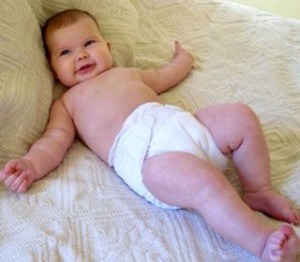There seem to be two types of people when it comes to cloth diapers. There are those who are nuts over cloth, and there are those who think people who use cloth are just nuts. The first group can get pretty passionate, going so far as to come up with their own language to talk about cloth diapers: AIOs, doublers, fitteds, prefolds, etc. It can get a little crazy. Do a quick Internet search for “cloth diapering tips” and you’ll see what I mean.
My husband and I are part of the crazies who love cloth diapers. Our daughter, Harlow, has been in cloth since day one, and I wouldn’t have it any other way five months later. She looks adorable in them, I don’t even know what diaper rash looks like, and we have saved a ton of money already (don’t believe me? See how much you can save HERE and HERE)

But, alas, we have hit our first bump in the road. Well, more like a puddle in the road. Cloth diaper fans know what I’m talking about: the infamous nighttime leak.
Nighttime leaking can be so persistent it leads even the most steadfast cloth lovers to disposables for bedtime. We were leak free for months when Harlow decided she preferred sleeping on her stomach. Suddenly I was washing sheets every night at 2 a.m., which is not my idea of a good time.
I felt too invested in cloth to switch, even if it was just for nighttime. The only alternative was to find a solution that worked. Fortunately, there are a lot of options for nighttime diapering. We’ve experimented with a few of these with my daughter, and we’ve found a solution that works for us for the time being. With all of these options, every family should be able to find a solution that will allow them to keep using cloth at night.
Extra layers: whether you use pocket diapers, fitteds or prefolds, adding an extra layer or two may be all you need to stay leak free. (This worked for us until my daughter started sleeping on her tummy a few weeks ago.)
More absorbent materials: most diapers are made with cotton or microfiber, but hemp is actually able to hold a lot more. (This is our current nighttime solution: one hemp insert under a microfiber insert. Leak free once again!)
A good fit: gaps in the legs or waist can cause leaching. Making sure the diaper has a snug fit could be the answer.
Wool: many people swear by wool for nighttime diapering. You can find wool inserts but wool covers or pants (sometimes called “soakers”) provide the best coverage. Just stick them on over your regular diaper for extra protection against leaks. Wool has the unique ability to absorb and hold liquid so it doesn’t leak, and all that’s required is a bit of airing out with an occasional wash.

We are happy and dry with the hemp inserts. That could change as Harlow grows, but I am enjoying not having to do laundry in the moonlight for now.
What are your nighttime diapering methods? Do you use cloth or disposables to keep your little one dry?









